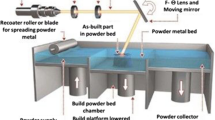Abstract
Based on the macroscopic constitutive models (MCCM), the Gurson damage model is introduced to build the mesoscopic constitutive models (MSCM) with anisotropy Gurson-Hill1948 and Gurson-Yld2003 damage models. The damage parameters of the Gurson-Hill1948 and Gurson-Yld2003 damage models using orthogonal analysis and inverse computed methods are discussed and compared with experimental and simulation results obtained using the user subroutine VUMAT implemented by Lin. The corresponding sensitivity of the damage parameters was obtained by orthogonal analysis, then these optimized damage parameters could describe the mechanical performance for 08Al sheet with 1 mm thickness. Basically, the simulation results are in accordance with the experiment results. The damage parameters of the Gurson-Hill1948 and Gurson-Yld2003 constitutive models are explored to describe the deep-drawing deforming process, failure performance and obtained equivalent stress, equivalent plastic strain, thickness, damage distribution, and the influence of the friction coefficient during the deep-drawing process.
Similar content being viewed by others
References
Hill R (1948) A theory of the yielding and plastic flow of anisotropy metals. P Roy Soc Lond A Mat 193:281–297
Barlat F, Brem JC, Yoon JW (2003) Plane stress yield function for aluminum alloy sheets—part 1: theory. Int J Plastic. 19(9):937–963
Hill R (1979) Theoretical plasticity of textured aggregates. Math Proc Cambridge 85:179–191
Hill R (1993) A user-friendly theory of orthotropic plasticity in sheet metals. Int J Mech Sci 35(1):19–25
Barlat F, Lian K (1989) Plastic behavior and stretchability of sheet metals. Part I: a yield function for orthotropic sheets under plane stress conditions. Int J Plastic. 5(1):51–56
Aretz H (2005) A non-quadratic plane stress yield function for orthotropic sheet metals. J Mater Process Technol 168(1):1–6
Hosford WF (1972) A generalized isotropic yield criterion [J]. Journal of Applied Mechanics of ASME 39:607–609
Lin, J, 2010. Study on theory and key technologies of numerical simulation for hydro-mechanical deep drawing process. Dissertation, Xi’an Jiaotong University.
Shang HX, Mohanram A, Olevsky E, Bordia RK (2016) Evolution of anisotropy in hierarchical porous ceramics during sinter-forging. J Eur Ceram Soc 36(12):2937–2945
Xue X, Liao J, Vincze G, Sousa J, Barlat F, Gracio J (2016) Modelling and sensitivity analysis of twist springback in deep drawing of dual-phase steel. Mater Des 90(15):204–217
Bandyopadhyay K, Panda SK, Saha P, Padmanabham G (2015) Limiting drawing ratio and deep drawing behavior of dual phase steel tailor welded blanks: FE simulation and experimental validation. J Mater Process Technol 217:48–64
Taherizadeh A, Green DE, Yoon JW (2011) Evaluation of advanced anisotropy models with mixed hardening evaluation of advanced anisotropy models with mixed hardening for general associated and non-associated flow metal plasticity. Int J Plastic 27(11):1781–1802
Barlat F, Lege DJ, Brem TC (1991) A six-component yield function for anisotropy materials. Int J Plast 9:693–712
Safaei M, Zang SL, Lee MG, Lee MG, Waele WD (2013) Evaluation of anisotropy constitutive models: mixed anisotropy hardening and non-associated flow rule approach. Int J Mech Sci 73:53–68
Moayyedian F, Kadkhodayan M (2015) Combination of modified Yld2000-2d and Yld2000-2d in anisotropy pressure dependent sheet metals. Lat Am J Solids Stru 12(1):92–114
McClintock FA (1968) A criterion for ductile fracture by the growth of holes. J Appl Mech 35(2):363–371
Rousselier G (1987) Ductile fracture models and their potential in local approach of fracture. Nucl Eng Des 105(1):97–111
Tvergaard V (1981) Influence of voids on shear band instabilities under plane strain conditions. Int J fracture 17:389–470
Guo JH, Zhao SD, Murakami R-i, Zang SL (2013) Experimental and numerical investigation for ductile fracture of Al-alloy 5052 using modified Rousselier model. Comput Mater Sci 71:115–123
Xu F, Zhao SD, Han XL (2014) Using of a modified Gurson model for the failure behavior of the clinched joint on Al6061 sheet. Fatig Fract Eng Mater Struct 37:335–348
Malte W, Eric L, Marek H, Jens-Pete M, Soren O (2015) Explicit FEM analysis of the deep drawing of paperboard. Mech Mater 89:202–215
Lin J, Zhao SD, Zhang ZY, Wang ZW (2009) Deep drawing using a novel hydro-mechanical tooling. Int J Mach Tool Manu 49(1):73–80
Lin J, Chan LC, Wang L (2010) Prediction of forming limit diagrams based on shear failure criterion. Int J Solids Struct 47(21):2855–2865
Wen T, Wang H, Yang C, Liu LT (2014) On a reshaping method of clinched joints to reduce the protrusion height. Int J Adv Manuf Technol 71(9–12):1709–1715
Karupannasamy DK, Hol J, De Rooij MB, Meinders T, Schipper DJ (2014) A friction model for loading and reloading effects in deep drawing processes. Wear 318(1–2):27–39
Zhang SH, Jensen MR, Danckerta J, Nielsen KB, Kang DC, Lang LH (2000) Analysis of the hydro-mechanical deep drawing of cylindrical cups. J Mater Process Technol 103(3):367–373
Brosius A, Mousavi A (2016) Lubricant free deep drawing process by macro structured tools. CIRP Ann-Manuf Techn 65(1):253–256
Author information
Authors and Affiliations
Corresponding author
Rights and permissions
About this article
Cite this article
Xu, F., Lin, J., Zhao, S. et al. Research of the Gurson damage model of the different yield functions during the deep-drawing process. Int J Adv Manuf Technol 91, 1643–1659 (2017). https://doi.org/10.1007/s00170-016-9873-9
Received:
Accepted:
Published:
Issue Date:
DOI: https://doi.org/10.1007/s00170-016-9873-9




